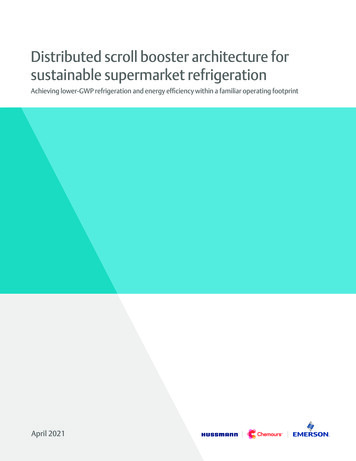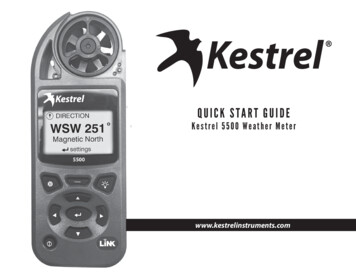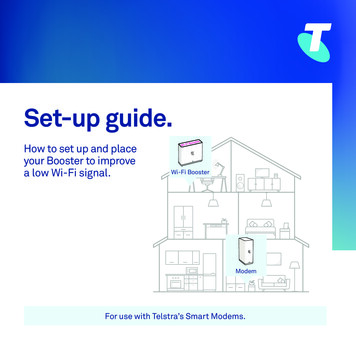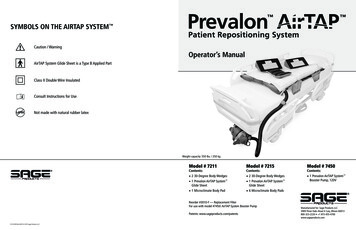
Transcription
Distributed scroll booster architecture forsustainable supermarket refrigerationAchieving lower-GWP refrigeration and energy efficiency within a familiar operating footprintApril 2021
AbstractDepending on their unique operational goals and/orregulatory mandates, food retailers and convenience storeGlobal, national and regional mandates are driving significantoperators find themselves at widely varying points along thechanges in commercial refrigeration system design tosustainability continuum. Not all supermarket operators areminimize their global warming potential (GWP) and/or totalready to assume the lifecycle costs and service challengesequivalent warming impact (TEWI). Conventional large,that come with a system operating below 150 GWP. Unlikecentralized direct-expansion (DX) refrigeration systems, whichthe past several decades when centralized DX systems weretypically utilize large charges of high-GWP hydrofluorocarbonthe prevailing architecture used in supermarkets, there(HFC) refrigerants, are prone to leaks and often suffer fromcurrently is no single system architecture that addresses thedeclining system performance over their lifespan. Whilewide range of sustainability objectives.natural refrigerants like CO2 (R-744) and propane (R-290)offer ultra-low-GWP levels, they also introduce operationalAmong the leading options for achieving this diversity ofcomplexities that many food retailers may not be prepared tosystem sustainability goals include utilizing lower-GWPaddress. Hydrofluoroolefin (HFO) refrigerant blends — such asrefrigerants and deploying lower-charge, distributedR-513A — offer a simpler alternative while providing excellentsystems. Refrigerant alternatives R-744 and R-290 offerperformance characteristics and much lower GWP than HFCs.ultra-low-GWP levels, but they also come with significantWhen used in emerging distributed booster architectures,operating caveats and design limitations related to highR-513A can present a low-charge, flexible alternative to largeoperating pressure (R-744) and flammability (R-290).centralized systems. This white paper will introduce thedistributed scroll booster architecture, designed for use withR-513A to deliver significant sustainability improvements andlower lifecycle costs — all within a safe and familiar operatingfootprint for supermarket owners/operators and serviceBlends of HFO alternatives, such as R-513A, offer very similarperformance characteristics to the low-pressure R-134a —only with a much lower GWP. And since R-513A is classifiedas an A1 refrigerant, it requires no special safety mitigationstrategies in system design.technicians.Evolving refrigeration system design criteriaTo support diverse sustainability requirements and theneed for refrigeration flexibility, distributed refrigerationFor more than 30 years, the evolution of commercialarchitectures are becoming a much-preferred alternativerefrigeration system design has been largely driven byto large centralized DX systems. They support the goals ofenvironmental sustainability initiatives. Recent designreducing direct and indirect emissions from refrigerationstrategies are typically aimed at lowering the totalsystems by utilizing reduced charges of lower-GWPequivalent warming impact through two approaches:refrigerants and system design strategies that maximize1) reducing direct emissions from refrigerant leaks, andenergy efficiencies.2) lowering the system’s total energy consumption (i.e.,Balancing sustainability and serviceabilityits indirect emissions).Refrigerant choice — a key component of system design — isAt the same time, many supermarkets are guided by theirown aggressive corporate sustainability goals and activelyplan for a transition to lower-GWP systems. But this journeyintroduces new challenges as operators try to find their idealbalance among sustainability goals, system costs and longterm serviceability considerations.2an important consideration for owners/operators. Whenevaluating total lifecycle costs, operators must not onlyfactor in the initial equipment investment and installationcosts, but also the long-term costs related to maintenanceand system serviceability.
Systems that are designed to use ultra-low-GWPrefrigerants, like R-744 and R-290, present unique systemmaintenance and operational challenges. For example,since R-744 is a high-pressure refrigerant used in complexsystem architectures, operators must have access toqualified service technicians to keep the system runningoptimally. R-290, which is classified as a highly flammableA3 refrigerant, requires mitigation strategies as well asbuilding and fire code approval from local authorities havingjurisdiction (AHJ). R-290’s very low charge restrictions alsolimit its application potential beyond self-contained cases.Distributed scroll booster: Elevating performanceand sustainabilityA distributed scroll booster architecture is designed formaximum application flexibility and optimized for use witha low-pressure refrigerant like R-513A. Configurations canscale from small, low-charge systems utilizing condensingunits to larger systems of distributed racks charged withseveral hundred pounds of refrigerant (see Figure 1).One design feature that makes this booster architectureunique is its use of a single refrigerant (R-513A) for bothlow- and medium-temperature refrigeration loads. ThisR-513A offers a low-pressure, high-performance and high-approach simplifies system design while maximizing overallefficiency alternative to these complexities. Designed as aefficiencies.replacement for R-134a, R-513A is an approved low-pressuresubstitute with zero glide that has been used in a wideCondenserScroll Booster RackRed Discharge gasYellow LiquidGreen Medium-temp. suction gasvariety of medium-temperature commercial refrigerationapplications. With its A1 classification, it provides thelowest possible GWP (573) among available non-flammablerefrigerant alternatives and presents no risk of ozonedepletion. Compared to R-134a, R-513A provides a 56%reduction in GWP.Scroll RackCoolerFreezerFreezerFreezerFor operators and service technicians, R-513A’s low-pressurecharacteristics provide a familiar operating envelope andCoolerrequire no special training, certification or safety mitigationmeasures. From a system design perspective, it provides thelowest boiling point of any refrigerant like R-134a, giving itCoolermore flexibility for use in low-temperature operation thanScroll Booster Condensingother alternatives in a similar pressure range.Condensing UnitR-513A: By the numbers GWP 573 — per the Fifth Assessment Report (AR5)of the United Nations Intergovernmental Panel onClimate Change (IPCC) 56% GWP reduction compared to R-134aLow-TempMedium-Temp 55% GWP reduction compared to R-448A/R-449A Ozone depletion potential (ODP) 0 ASHRAE A1 safety classification Azeotropic blend with zero glide Performs well in all ambient conditionsLow-TempMedium-TempFigure 1: Distributed scroll booster system configurations3
Overcoming low-temperature challengesDistributed scroll booster technology is designed toovercome the common challenges of operating a lowtemperature system, which often include: requiring acompressor cooling strategy such as liquid injection;lowering compressor lifespan due to high compression ratiosand discharge temperatures.compressors can either be located within a condensingunit or in a standard rack configuration. Condensers canbe located remotely or integrated into the system andplaced indoors or outdoors. Low-temperature compressorsare placed near the low-temperature evaporators, whichhelps to reduce refrigerant charge, piping and associatedcosts (see Figure 2). For example, in supermarket reach-infreezers, this could be directly on top of or beside the case orInstead, the distributed scroll booster’s straightforwardremotely near the load.architecture leverages the advantages of R-513A’s low-This system design strategy provides a performance boostpressure, high-efficiency and key system componentsby discharging the low-temperature compressor directly intoto provide:the nearest medium-temperature compressor’s suction line. Lower discharge temperatures and compression ratios:The lower discharge temperatures of the low-temperature1.9:1 at -10 F saturated suction temperature (SST) andscroll compressor minimize the suction gas temperature20 F saturated discharge temperature (SDT)of the medium-temperature unit and allow the medium- Reduced compressor strain and related maintenanceissues Increased overall system efficiency and lifespan Reduced stress on pipes and fittings, which lowers thepotential for leakstemperature compressors to operate within their designlimits without the need for additional cooling.The net result of boosting low-temperature compressorsdirectly into the medium-temperature compressorsis an overall system efficiency gain while keeping themechanical load on the low-temperature compressors veryMechanics of a distributed scroll booster systemlow. Compared to conventional systems, where the lowtemperature scrolls are subject to the most demandingThe core of the system is comprised of one or morehigh-compression ratios and high-discharge temperatures,medium-temperature compressors coupled with one orthe distributed scroll booster system operates at consistentlymore low-temperature compressors. Medium-temperaturelow and predictable values.CondenserDistributed Scroll Booster SystemRed Discharge gasYellow LiquidGreen Medium-temp. suction gasScroll RackCoolerFreezerFreezerFreezerCoolerCooler4Figure 2: Low-temperature compressors arelocated near low-temperature evaporators.
Distributed scroll booster:Performance analysesProof of concept: Gem City MarketThermodynamic analyses of a distributed scroll boosterserviceability made the distributed scroll booster an idealsystem in Los Angeles demonstrate its performancechoice for a new small-format supermarket built in a foodcharacteristics compared to other supermarket systemdesert in Dayton, Ohio. The project involved collaborationarchitectures. Using a centralized DX as the baseline foramong the affected Dayton community, city officials andcomparison, Figures 3 and 4 evaluate the annual energy,commercial refrigeration industry leaders, who donatedpeak load and lifecycle climate performance (LCCP) oftheir respective expertise and resources to the project.The combination of high performance, sustainability andthese systems. The loads used for analyses were 100,000 Chemours — Opteon XP10 (R-513A) refrigerantBtu/hr (29.3 kW) for the medium-temperature and Hussmann — medium-temperature Protocol systems,33,000 Btu/hr (9.67 kW) for the low-temperature. SST forthe low-temperature is -25 F (-31.7 C) and 20 F (-6.7refrigeration units and display cases with CoreLink, C) for the medium-temperature.micro-channel condensers, unit coolers and extensivecommercial refrigeration expertiseAnnual Energy and Peak Power Consumption8.3%-10.3%120,00025.0Copeland scroll booster low-temperature modules,4.6%-7.5%-4.1%-16.9%Lumity site supervisor facility management control,20.09.0%-11.5%-8.4%100,000 Emerson — Copeland scroll compression technology,25.6% Peak4.2%140,000Annual Energy (kWh) MT Annual15.0-19%80,00010.060,00040,000Peak Power (kW) LT )Distributed(R-407A)Secondary,Glycol MT,CO2 icalScroll Booster Booster ParallelCO2TranscriticalBoosterFigure 3: Comparison of annual energy and peak power consumptionXM case controls, electronic expansion valves (EEVs) andexpertise in distributed scroll booster architectureThe collaboration with Gem City Market stakeholders tookplace within The Helix Innovation Center, an Emerson facilitylocated on the University of Dayton campus. The teamdesigned a custom configuration of the distributed scrollbooster system according to the store’s unique footprint,floor plan and refrigeration requirements.Annual CO2 EmmissionThe inherent advantages of the refrigeration system LT Direct-45.2%CO2 Transcritical Booster LT Indirect MT DirectCO2 Transcritical Booster - Parallel MT Indirect-51.7%aligned well with the market’s financial, operational andenvironmental sustainability goals of:-57.0%R-513A Distributed Scroll BoosterR-134a/CO2 Cascade Low-GWP refrigeration-41.1%R-407A Secondary, Glycol MT, CO2 LT Long-term energy savings-43.6%R-407A Distributed Low operating costs-36.6%R-404A Centralized-50,00020,000100,000150,00040,000 60,000200,000250,000300,000 350,000400,000 Familiar servicing footprint80,000 100,000 120,000 140,000 160,000 180,000The store opened in spring 2021.Figure 4: Lifecycle climate performance5
Conclusion: Wide industry potentialand benefitsThe unique combination of a low-pressure, low-GWPrefrigerant and a simple, distributed architecture based onfamiliar operating principles fills an urgent need within thelarger food retail market. For operators who seek to meettheir sustainability goals without introducing unnecessaryserviceability complexities, a distributed scroll boostersystem is an ideal choice.While its design flexibility lends itself to store formats ofvarying sizes, its benefits check many key boxes on the list ofmodern supermarket refrigeration priorities: Lower-GWP, A1 refrigerant (R-513A) Reduced refrigerant charge Lower leak rates due to lower-pressure system Lower utility costs System familiarity with technicians and end users Low total cost of ownership (from lower annual energyconsumption and LCCP) Secure remote facility monitoring capabilitiesIn the future, as even lower-GWP refrigerants (such as A2Ls)are approved for use by applicable codes and standards, thedistributed scroll booster system can be adapted for use withultra-low alternative refrigerants (less than 150 GWP).For more information about the distributed scroll boosterarchitecture, please contact this paper’s authors.6
AuthorsAndre Patenaudeto Emerson’s food retail and chiller markets. Prior to that,Director of Solutions Integrationhe had managed Emerson’s global CO2 development.EmersonAndre has more than 35 years of industry experience in sales,andre.patenaude@emerson.commarketing, training and business development of HVACRsystem architectures and applications with compressionAndre Patenaude is responsible for supporting system-and component technologies. He is a certified Mechanicalrelated innovation and leveraging Emerson’s global coldEngineering Technologist C.E.T. (since 1984), and is achain to drive adoption of integrated solutions in Northmember of AHRI, ASHRAE and RSES.America. He most recently led marketing efforts pertainingDr. Charles AllgoodPrior to joining DuPont, he worked as a research chemist forTechnology Leader — Refrigerantsthe National Institute of Standards and Technology. He hasChemourscharles.c.allgood-1@chemours.comDr. Charles Allgood is the technology leader — refrigerantswith Chemours in Wilmington, Del. He currently leadsheld a variety of research, technical service and marketdevelopment assignments during his 25 years in therefrigerants industry.Dr. Allgood earned a Ph.D. in chemistry from the Universityof Delaware.the company’s technical support, training and applicationsdevelopment for the Opteon and Freon refrigerants andis a frequent speaker at many HVACR industry events.Andres LacassieExchange Locker, microDS, Freedom Line and Self-ContainedVice President, Core and DistributedCases Product Linemerchandisers. In his role, Andres has accelerated theHussmann CorporationNorth America. He also currently serves on the planningleadership position for refrigerated merchandisers acrosscommittee for the annual FMI E SD conference, which isandres.lacassie@hussmann.comfocused on innovations and technologies that propel theAs the vice president of the core and distributed cases productfood retail industry forward.line at Hussmann, Andres Lacassie is responsible for theAndres earned a bachelor’s degree in communication fromdevelopment and delivery of the company’s largest productthe University of New Orleans and an MBA in internationalportfolio, including Insight Multideck, Reach-In, Smartmarketing from the University of Dallas.7
About EmersonEmerson (NYSE: EMR), headquartered in St.Louis, Missouri (USA), is a global technologyand engineering company providing innovativesolutions for customers in industrial,commercial and residential markets. OurEmerson Automation Solutions businessis a leader in helping process and discretemanufacturers automate and optimizeproduction processes through our best-inclass technologies and industry expertise. OurEmerson Commercial & Residential Solutionsbusiness develops technologies and servicesthat improve human comfort, safeguard food,protect the environment, enable sustainablefood waste disposal, and support efficientconstruction and maintenance of buildings andmunicipal infrastructure. For more information,visit Emerson.com.Emerson.com2020ECT-3 (04/21) Emerson is a trademark of Emerson Electric Co. 2021 Emerson Climate Technologies, Inc. All rights reserved.
To support diverse sustainability requirements and the need for refrigeration flexibility, distributed refrigeration architectures are becoming a much-preferred alternative to large centralized DX systems. They support the goals of reducing direct and indirect emissions from refrigeration systems by utilizing reduced charges of lower-GWP











